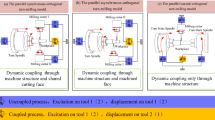Abstract
Heavy-duty milling processes find productivity limitations due to chatter vibrations related to the dynamic flexibility of the machine tool structure. In high-speed machining, the critical dynamic properties and the resultant process stability are highly dependent on the tool or tool holder and not on the machined part, the machining position or the feed direction. The latter factors have, however, a significant impact on stability of heavy-duty operations, which makes the current stability models unsuitable for the stability prediction of this kind of operations. The present study proposes a standard stability model with specific improvements focused on heavy-duty operations, considering the whole workspace and feed directions. This model is used as the basis for the development of a universal process planning and tool selection methodology. Finally, the proposed method is experimentally verified in two practical cases, where a typical steel roughing operation is successfully optimised for two different machines. The usefulness of the developed methodology is demonstrated.
Similar content being viewed by others
References
Tobias SA, Fishwick W (1958) Theory of Regenerative Machine Tool Chatter, The Engineer, 205
Tlusty J, Polacek M (1963) The Stability of the Machine Tool against Self-Excited Vibration in Machining, ASME Production Engineering Conference, 454–465
Altintas Y, Budak E (1995) Analytical prediction of stability lobes in milling. Ann CIRP 44(1):357–362
Jensen SA, Shin YC (1999) Stability analysis in face milling operations, Part 1: theory of stability lobe prediction. J Manuf Sci Eng 121(4):600–605
Altintas Y (2001) Analytical prediction of three-dimensional chatter stability in milling, Japan society of mechanical engineers-international journal series c: mechanical systems. Mach Elem Manuf 44(3):717–723
Altintas Y, Engin S (2001) Generalised modelling of mechanics and dynamics of milling cutters. CIRP Ann 50(1):25–30
Munoa J, Zatarain M, Bediaga I, Lizarralde M (2005) Optimization of hard material roughing by means of a stability model. Eighth CIRP International Workshop on Modelling of Machining Operations, Chemnitz, Germany, pp 431–438
Munoa J, Zatarain M, Dombovari Z, Yang Y (2009) Effect of Mode Interaction on Stability of Milling Processes. Proceedings of the CIRP, 12th CIRP Conference on Modelling of Machining Operations, San Sebastian, Spain
Bayly PV, Halley JE, Mann BP, Davies MA (2002) Stability of interrupted cutting by temporal finite element Analysis. J Manuf Sci Eng 125:220–225
Insperger T, Stepán G (2002) Semi-discretisation method for delayed systems. Int J Numer Methods Eng 55(5):503–518
Budak E, Altintas Y (1998) Analytical prediction of chatter stability in milling-Part 1: general formulation. J Dyn Syst Meas Control 129:22–30
Merdol D, Altintas A (2004) Multi-frequency solution of chatter stability for low immersion milling. J Manuf Sci Eng 126:459–466
Zatarain M, Munoa J, Peigne G, Insperger T (2006) Analysis of the influence of mill helix angle on chatter stability. CIRP Ann 55(1):365–368
Ahmadi K, Ismail F (2011) Analytical stability lobes including process damping effect on machining chatter. Int J Mach Tool Manuf 51(4):296–308
Altintas Y, Weck M (2004) Chatter stability of metal cutting and grinding. CIRP Ann 53(2):619–642
Schmitz TL, Powell K, Won D, Duncan GS, Sawyer WG, Ziegert JC (2007) Shrink fit tool holder connection stiffness/damping modelling for frequency response prediction in milling. Int J Mach Tool Manuf 47(9):1368–1380
Author information
Authors and Affiliations
Corresponding author
Rights and permissions
About this article
Cite this article
Iglesias, A., Munoa, J. & Ciurana, J. Optimisation of face milling operations with structural chatter using a stability model based process planning methodology. Int J Adv Manuf Technol 70, 559–571 (2014). https://doi.org/10.1007/s00170-013-5199-z
Received:
Accepted:
Published:
Issue Date:
DOI: https://doi.org/10.1007/s00170-013-5199-z



